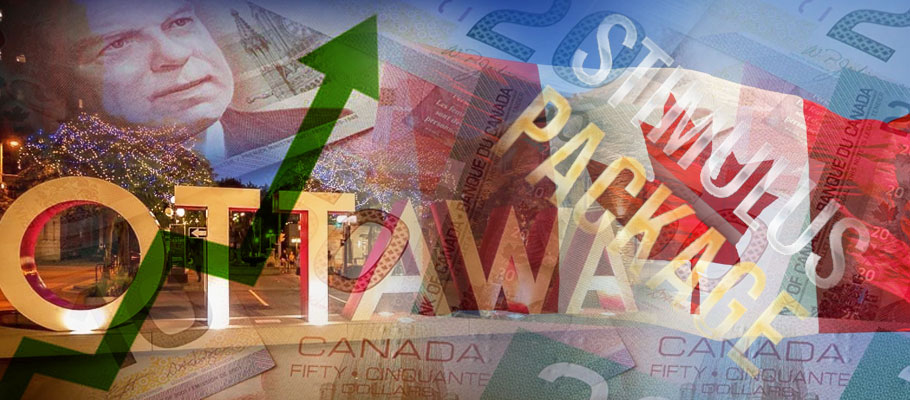
Published: October 15th, 2025
Canadian Prime Minister Mark Carney will deliver his first federal budget on November 4th, a moment investors hope will mark a shift in Ottawa's economic stance. The new prime minister has telegraphed a willingness to let the deficit widen towards 3% of GDP in pursuit of investment-heavy stimulus.
For forex traders it could be an inflection point: fiscal policy, after years of caution, may turn supportive for growth, and by extension, supportive for the Canadian Dollar (CAD).
A recent note from Bank of America's (BoA) FX strategy unit argues that a sizable fiscal package would act as a “bullish catalyst” for the Loonie.
It's not hard to understand why. Higher government outlays would inject demand into the economy, raise inflationary expectations, and potentially deter the Bank of Canada (BoC) from continuing its easing cycle. If markets begin to price in future rate increases rather than cuts, the appeal of holding Canadian assets improves.
Ottawa's fiscal profile gives it room to manoeuvre. Analysts point out that, judged by the usual metrics, namely long-dated bond yields, debt-to-GDP ratios and interest-service costs, Canada remains in sounder shape than several other advanced economies.
The United States, Britain and France have all suffered fiscal shocks this year that rattled bond markets. Canada, by contrast, still enjoys a modest risk premium; a drift to a deficit nearer 3% of GDP would raise eyebrows but is unlikely, for now, to spark a market revolt.
Fiscal credibility makes the difference between a stimulatory budget that lifts sentiment and one that merely unnerves investors. Mr Carney, a former central banker twice over, enters Parliament with a reputation for financial sobriety.
That gives him political space to loosen the purse strings slightly without alarming bondholders, provided the spending is framed as investment rather than consumption.
Domestic asset markets are already signalling optimism. The Toronto Stock Exchange (TSX) has outpaced Wall Street and most other indices this year and is on track for its strongest annual performance since 2009. Historical patterns show that after rolling 20% gains in the index, subsequent quarters tend to deliver above-average GDP growth more than three-quarters of the time. The link is not mechanical, but it shapes expectations: when equity markets perform well, investors are more willing to believe in a real-economy follow-through.
That optimism matters for currency flows. A budget that supports the equity narrative could draw in additional foreign capital. In that scenario, the loonie, which has drifted against the US dollar in recent weeks, could rediscover momentum.
The currency's resilience has already been tested. The US dollar has recently surged, pushing USD/CAD above 1.40, a level last seen in the spring. Much of the move reflects safe-haven flows rather than enthusiasm about US fundamentals.
Even so, the loonie has held up better than some peers: both sterling and the euro have fallen more sharply against it, with GBP/CAD sliding towards 1.86 and EUR/CAD dipping below 1.63.
That relative strength is fragile. Global risk sentiment remains skittish. A fresh flare-up in trade tension between Washington and Beijing reminded investors how quickly markets can be knocked off course.
When the US president declared that a 100% tariff on Chinese imports was back on the table, currencies across the board lurched. The loonie, typically sensitive to risk appetite, sold off alongside.
The rhetorical tempo has softened in recent days. “Don't worry about China, it will all be fine! Highly respected President Xi just had a bad moment,” the US president wrote on Truth Social, striking an oddly conciliatory note. JD Vance, the vice-president, told broadcasters that negotiations would be “a delicate dance”.
Beijing, for its part, urged dialogue. Analysts at a large Nordic bank suggested that these comments imply active back-channel talks and raise the prospect of a face-saving truce later in the month.
Forex traders, mindful of recent whiplash, might be reluctant to chase either optimism or despair too far. The premium attached to trade risk remains embedded in prices, keeping GBP/CAD in a holding pattern and limiting CAD's ability to mount a decisive comeback.
Commodity prices complicate the picture further. Canada's export profile remains heavily tied to oil. When fears of a trade war intensified, crude prices slid; West Texas Intermediate sank towards the high-$50s. Lower oil prices dampen Canada's terms of trade and typically weigh on the currency. A renewed fiscal push could therefore find itself offset by weaker commodity revenues.
This tug of war between domestic stimulus and external headwinds will define the Loonie's trajectory into year-end, BoA says. A budget designed to galvanise investment may be enough to shift sentiment, but not if global demand looks shaky and energy prices stay soft.
Monetary policy acts as the hinge between fiscal stimulus and currency price action. If stronger public spending begins to stoke inflation, the Bank of Canada may see little justification for further cuts. Markets might even begin to price in tightening. That repricing alone would firm yields and support the loonie without a single rate move being delivered.
Should the bank judge that global risks outweigh domestic demand, however, it may keep policy accommodative despite fiscal activism. In that case, any currency bounce could prove short-lived. The loonie's fate, then, depends not just on Ottawa's willingness to spend but on the Bank's judgment of whether that spending will stick.
November 4 may serve less as a turning point than a litmus test. Ottawa has an opportunity to reset expectations and harness a moment of relative market goodwill. The Loonie, long battered by external shocks, could at last find support from home.
But in a world where tariffs can be levied before breakfast and reversed by lunch, fiscal tinkering may not be enough. The best Mr Carney can hope for is to tilt the odds. Whether CAD takes flight or merely flutters depends on forces well beyond Ottawa's control.